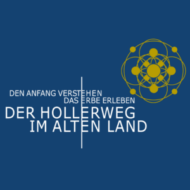UNIQUE TRADITIONS
A unique, splendid and confident farming culture developed in the Altes Land. Altländer culture, elaborate filigreed costumes and artistically turned furniture continue to be maintained and created today. The rural municipality was called Altes Land, and the ancient regional seal from 1361 was inscribed with Sigillum Communitatis Veteris Terrae (“Seal of the Municipality of the Altes Land”). For the first time in 1361, captains became institutionalised bodies of the rural municipalities in the Elbe marshlands.
“At most, having autonomous rural municipalities as a historical background to a cultural landscape which was shaped by the Dutch and which then evolved independently is a considerably unique characteristic that the Altes Land shares with the municipality of Hadeln. A special highlight of the Altes Land is the fact that with the emergence of the major crews in the 14th century, the separation between jurisdiction and administration was already being anticipated; it was only in the 19th century that this separation occurred in central Europe. In addition to the cities, the importance of the rural municipalities as they relate to the enforcement of modern civil society is to be assessed with high regard.” Adolf E. Hofmeister
It was only when the district of Jork disbanded in 1932 that the centuries-old unity of the Altes Land was destroyed.
Since the 15th century, courts have remained the undivided property of one family for generations. Ownership structures, topography, rule-based conditions, contractual arrangements and legal relations shaped the daily lives of people in the Altes Land in a special way over the past centuries. The Olden Landes Ordeninge und Rechteboeke regulated the rule of law. Woman always held a very strong position in the Altes Land so that, for example, a jointly composed will could not be unilaterally changed to the detriment of the other.
In the 17th century, skilled crafts and trades could already develop in the Altes Land independently of the banal rights of tradesperson offices in the neighbouring cities of Stade and Buxtehude. If a high value was placed on the design of the house, a lot of money was also spent on arranging the interior. Altländer furniture has been preserved, most notably in the form of suitcase chests. This also extends to settles, chairs and the so-called Hamburg Schapp, a distinct baroque hall closet. These furniture pieces can be found in museums and private homes.
Organ Landscape and Churches
The ten listed churches in the Altes Land are rich in cultural treasures. Unlike almost anywhere else in the world, this is where a stock of historical and preserved organ stops from the pre-Baroque and Baroque periods can be found. Arp Schnitger, the master of organ building in northern Germany, lived and worked in Neuenfelde. To this day, the Orgelbauerhof (organ-building courtyard), his organs in the Altes Land, and his grave in St. Pankratius attract organ builders and church musicians from around the world.
The first evidence of organs can be traced back to 1560/62 for Jork, 1565 for Mittelnkirchen, 1583 for Borstel and 1584 for Estebrügge. There is evidence that Matthes Mahn, an organ builder from Buxtehude, was active in the Altes Land. In 1581 in Steinkirchen, an organ building contract to extend an existing instrument was recorded.



>>> GET THE APP ! <<<

